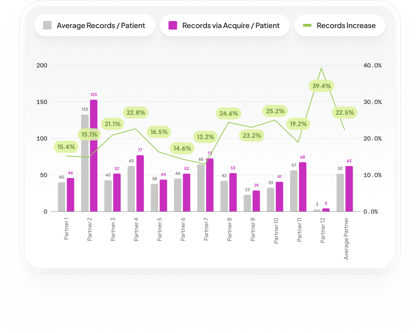3 Problems Keeping Healthcare Trapped in the 20th Century

It’s no secret that American healthcare needs to change. But in a system that is so complex, involves so many different players, and has such unique security and privacy considerations, it’s difficult to identify the specific problems we should focus on first.
At Credo, we believe that in order for healthcare to truly evolve, we first need to address some of the fundamental problems with how we collect, store, and transfer medical record data. After all, how can payers and providers be expected to deliver quality care or manage payments effectively when they don’t have access to timely, accurate information?
With that ethos in mind, here are three of the biggest problems we’ve identified as our top priorities for finally moving healthcare into the 21st century.
1. Paper Medical Records Put Providers at a Major Disadvantage
Did you know that the American healthcare industry spends $125 billion annually on medical record retrieval? And a large part of that spend is tied to the fact that clinical staff spend an average of 20% of their time each day chasing down patient records.
The problem is both complex and extremely simple: paper medical records do not work. They are a hassle to store, difficult to transfer, and often don’t contain all the information a digital record could include.

Let’s first talk about storage. Paper records take up an enormous amount of physical space, and because they’re not “searchable” like an electronic database, it can be nearly impossible to find the right piece of information in a timely manner. Most medical records also don’t have backups, so if a piece of information is destroyed by a natural disaster or even just a spilled drink, there’s no way to recover it.
The problem becomes even more pronounced when you need to transfer a medical record to another healthcare provider outside of your facility. Many health systems still rely heavily on the fax machine — and no, faxing technology has not improved since the 1980s. Faxed medical records are often blurry or completely illegible, and sometimes they don’t even arrive at all (or get sent to the wrong place entirely, which is a major security concern).
If the faxed record does arrive as it should, the clinician may still have trouble reading the handwriting, or they might not be able to quickly find the information they need, because of inconsistent formatting.
2. Electronic Health Record Products Lack Interoperability
Even when providers do make the switch to electronic health records (EHRs), the systems they use may not be able to exchange data with providers who use a different system.
There are hundreds of different government-approved EHR products in use. And because there’s no standardized language or format that all EHRs use, it can be difficult or impossible to transfer data from one system to another.
Even within the same health system, you might find that providers are using multiple EHRs, or using the same product in inconsistent ways, which makes it difficult for others to find the information they need.
These issues with medical record storage and transfer are not only an inconvenience and a time waster for providers, but they’re also dangerous for patients. When a provider doesn’t have immediate access to a full and clear picture of a patient’s health history and the treatments they’ve received, they can’t make informed decisions about which treatment methods are safe and which have the potential to be most effective.
This can be life threatening for patients with chronic conditions and also in emergency care situations. If you go to the hospital and need treatment right away, your doctor won’t have time to wait for a faxed medical record that could contain life saving information.
3. Patients Can’t Access Their Own Health Information
When patients can see and understand their health data, they’re better able to play an active role in their own health.
Unfortunately, our current systems make this unnecessarily difficult. Paper records are typically not made available to patients, and even when data is stored electronically, it’s usually not aggregated in one comprehensive and simple to understand record.

The industry has not historically prioritized this issue, but research shows that access to medical records helps patients build stronger relationships with their providers, better understand their treatments, and even take steps to improve their health.
In one study, patients who had medical record access used those records to trace symptoms back to potential root causes, prepare for doctors’ appointments, ask their providers better questions, remind themselves of recommended lifestyle changes, and more.
Digital Medical Record Retrieval, As It Should Be
At Credo Health, we’re on a mission to transform the way patients and providers access medical records. Our first-of-its-kind product allows us to discover, retrieve, and analyze records so that providers can easily find and interpret medical records right when they need them.
This not only saves time and money for providers, but it also significantly reduces risk and improves the member experience. To learn more about Credo’s unique solution and the benefits it could provide your organization, schedule a demo today.
Back to blog




